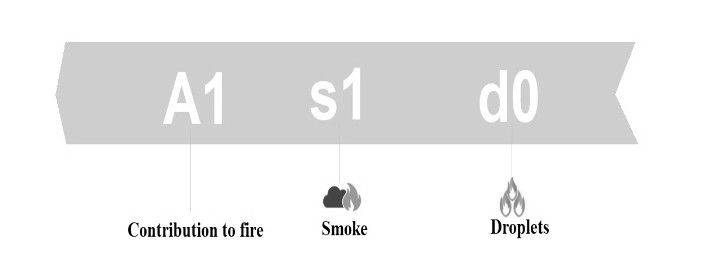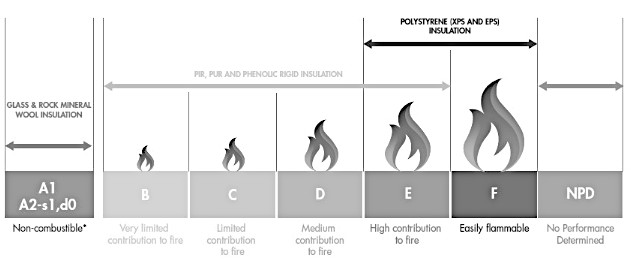FIRE RATING CLASSIFICATIONS GUIDE
Fire protection assessments following British Standard guidelines revolve around two key standards:
1.BS EN 13501-1,
Fire classification of construction products and building elements.
2.BS 476-1
Fire tests on building materials and structures,
The main test that fire rated insulation undergoes is BS EN 13501-1. The material is awarded an official fire rating classification, commonly referred to as a Euroclass rating.
EUROCLASS RATING
In 2000, the European Union introduced the Euroclass system to simplify how we understand the fire performance of construction materials. The goal was to make trade easier among EU countries. This test checks how fire-rated insulation acts during a fire, looking at:
- COMBUSTIBILITY AND CONTRIBUTION TO FIRE,
- SMOKE PROPAGATION, EMISSION,
- DROPLETS AND PARTICLES IN THE FIRST 10 MINUTES.


COMBUSTIBILITY / CONTRIBUTION TO FIRE
The primary Euroclass rating, identified by the letters A1, A2, B, C, D, E, or F, reflects the overall performance of the insulation. A1 signifies the highest level of performance, while F indicates the lowest.
Each rating corresponds to a specific classification, such as:
- Non-Combustible, (A1)
- Limited Combustibility, (A2)
- Combustible (B-F)
A1 - rated products are considered non-combustible.
A2 - rated products are classified as having limited combustibility.
B to F ratings indicate increasing levels of combustibility.
When utilising flooring materials, they will carry a 'fl' designation, for example, A1fl.
For linear pipe thermal insulation products, you'll find them marked with 'L,' as in the case of A1L. Insulation that falls within Class A1 or A2-s1,d0, which represents the highest level of fire safety, is referred to as "fire rated insulation".

Pic 1.Fire rating classification A1-F
Pic credit: knauf.co.uk
SMOKE PROPAGATION / EMISSION
In the fire rating system, the 's' category specifically addresses the extent of smoke propagation or emission. It is assessed on a scale ranging from 1 (minimal/weak) to 3 (substantial).
S1 – Emissions absent or very little
S2 – Emissions with average volume intensity
S3 – Emissions with high volume intensity

Pic 2. Fire rating classification S
DROPLETS / PARTICLES
The 'd' element within the rating system denotes the presence of 'flaming droplets and particles' within the initial 10 minutes of exposure, categorised as D0, D1, or D2, with D0 being the best and D2 being the least favourable. The classification breakdown is as follows:
d0: Indicates the absence of flaming droplets and particles.
d1: Signifies some presence of flaming droplets and particles.
d2: Represents a significant amount of flaming droplets and particles.
It's important to note that F-rated products do not fall into any of the mentioned 'd' classifications. On the contrary, A1-rated products do not receive either a smoke emission or flaming droplet classification, as they do not contribute to the spread of a fire.

Pic 3. Fire rating classification D
CLASS 0 AND CLASS 1 FIRE RATINGS
You may heard of products aiming for either Class 0 or Class 1 ratings. It's important to note that these labels do not necessarily reflect the product's combustibility. Rather, they specifically address the limited surface fire performance characteristics of the product.
CLASS 0
Class 0 is a designation outlined in Approved Document B of the Building Regulations 1991, determined through two separate tests in British Standard BS 476. The initial test examines a surface's role in fire spread (BS 476-6), and the second assesses the movement of flames across a surface, taking into account factors like distance and duration (BS 476-7).
This means that the material has met the criteria set by national standards, meeting requirements such as:
- Controlled Flame Spread: The material effectively prevents the spread of flames across its surface.
- Minimal Heat Emission: The material shows low heat release properties during combustion.
- Reduced Smoke Generation: The material minimizes smoke production when subjected to combustion.
Class 0 is typically mandated for materials used in specific settings such as emergency exits, tall structures, and buildings subject to stringent fire safety protocols.
CLASS 1
Conversely, Class 1 is a more limited classification derived solely from the test outlined in BS 476-7.
This classification denotes a surface with intermediate fire performance regarding flame spread. It confirms that the material has undergone fire testing and complies with the specified criteria in national standards, including:
- Controlled Flame Spread: The material has a limited capacity for flame spread across its surface.
- Moderate Heat Emission: The material exhibits moderate heat release characteristics during combustion.
- Moderate Smoke Generation: The material produces an acceptable level of smoke when exposed to combustion.
Class 1 is typically specified for materials used in general building scenarios, where a lower degree of fire resistance is deemed sufficient based on the specific context and regulations in place.
Related Searches:
THE ULTIMATE GUIDE TO 30-60-90-240 MINUTE A1 FIRE RATED BOARDS: BENEFITS AND APPLICATIONS
7 EASY TIPS FOR INSTALLING FOIL FACED INSULATION THE RIGHT WAY
DEMYSTIFYING FIRE RATINGS FOR INSULATION MATERIALS
*Insulationgo LTD strives to keep the content accurate and up-to-date, but we cannot be held responsible for any mistakes or exclusions.
The information in this article isn't expert advice and shouldn't replace talking to the right specialists. Before buying or deciding anything based on this info, it's best to contact the product manufacturer directly to double-check if it's right for what you need.
Descriptions, drawings, photographs, data, proportions, weights, and measured values provided here may change without prior notice and do not establish the guaranteed contractual quality of the products. The recipient of these products holds the responsibility to comply with proprietary rights, existing laws, and legislation.
Using this articles implies acknowledgment and agreement that Insulationgo LTD cannot be held accountable for any damages, losses, or inconveniences resulting from the use or reliance upon the information provided. This limitation of liability extends to all users of the article, including visitors, readers, and subscribers.










































































































